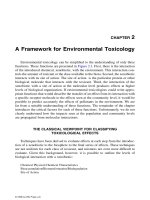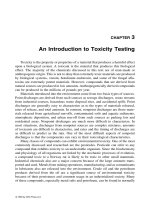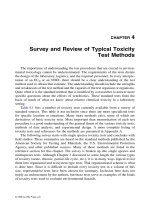Ebook A guide to molecular mechanics and quantum chemical calculations (3e) Part 2
Bạn đang xem bản rút gọn của tài liệu. Xem và tải ngay bản đầy đủ của tài liệu tại đây (10.71 MB, 404 trang )
Chapter 14
Dealing with
Flexible Molecules
This chapter addresses practical issues which arise in dealing with
flexible molecules. These include identification of the “important”
conformer (or set of conformers) and location of this conformer. The
chapter concludes with guidelines for fitting potential energy functions
for bond rotation to simple Fourier series.
Introduction
Conformation dictates overall molecular size and shape, and
influences molecular properties as well as chemical reactivity.
Experimental information about conformation is often scarce, and
computational methods may need to stand on their own. There are
actually two different problems associated with treatment of
conformationally-flexible molecules. The first is to identify the
appropriate conformer (or conformers), and the second is to locate it
(them). Both of these will be touched on in turn.
Identifying the “Important” Conformer
The equilibrium (“thermodynamic”) abundance of conformational
forms depends on their relative energies. According to the Boltzmann
equation, the lowest-energy conformer (global minimum) will be
present in the greatest amount, the second lowest-energy conformer
in the next greatest amount, and so forth.* This implies that reactions
under thermodynamic control and involving conformationally-flexible
reagents need to be described in terms of the properties of global
* This is not strictly true where certain conformers possess elements of symmetry. Here, the
number of occurences of each “unique” conformer also needs to be taken into account.
393
Chapter 14 asfd
393
3/25/03, 10:46 AM
minima, or more precisely in terms of the properties of all minima
weighted by their relative Boltzmann populations.
The situation may be markedly different for reactions under kinetic
control. Here, the lowest-energy conformer(s) of the reagent(s) may
not be the one(s) involved in the reaction. A simple but obvious
example of this is provided by the Diels-Alder cycloaddition of
1,3-butadiene with acrylonitrile.
+
CN
CN
The diene exists primarily in a trans conformation, the cis conformer
being approximately 2 kcal/mol less stable and separated from the
trans conformer by a low energy barrier. At room temperature, only
about 5% of butadiene molecules will be in a cis conformation. Clearly,
trans-butadiene cannot undergo cycloaddition (as a diene), at least
via the concerted pathway which is known to occur, and rotation into
a cis conformation is required before reaction can proceed.
Diels-Alder cycloaddition of 1,3-butadiene and acrylonitrile is
significantly slower than the analogous reaction involving
cyclopentadiene. Might this simply be a consequence of the difference
in energy between the ground-state trans conformer of butadiene and
the “cis like” conformer which must be adopted for reaction to occur, or
does it reflect fundamental differences between the two dienes? That is,
are activation energies for Diels-Alder cycloaddition of cis-butadiene
and of cyclopentadiene actually similar?
According to B3LYP/6-31G* calculations, the activation energy for
cycloaddition of cis-1,3-butadiene and acrylonitrile is 20 kcal/mol, while
the activation energy for the corresponding reaction involving
cyclopentadiene is 16 kcal/mol. The two are not the same, and the
difference in reactivity is more than the matter of conformation.
Interestingly, the difference in activation energies closely matches the
difference in the energies of cis and trans conformers of 1,3-butadiene
(4 kcal/mol from B3LYP/6-31G* calculations).
394
Chapter 14 asfd
394
3/25/03, 10:46 AM
A related example is the observation (from calculations) that DielsAlder reaction of 1-methoxybutadiene and acrolein gives different
regioproducts depending on the conformation of acrolein. Reaction
of trans-acrolein (the global minimum) gives the meta product (not
observed experimentally), while reaction of cis-acrolein, which is
about 2 kcal/mol higher in energy, leads to the observed ortho product.
O
+
+
meta adduct
O
ortho adduct
OMe
OMe
In both of these situations, the reaction actually observed does not
occur from the lowest-energy conformation of the reactants. That
this need not be the case is a direct consequence the Curtin-Hammett
principle 1. This recognizes that some higher-energy “reactive
conformation”, will be in rapid equilibrium with the global minimum
and, assuming that any barriers which separate these conformations
are much smaller than the barrier to reaction, will be replenished
throughout the reaction.
chemical reaction
"high-energy process"
E
equilibration among conformers
"low-energy process"
In the case of the above-mentioned Diels-Alder reactions, the reactant
conformers are separated by energy barriers which are far smaller
than the activation required for cycloaddition.
It is clear from the above discussion that the products of kineticallycontrolled reactions do not necessarily derive from the lowest-energy
conformer. The identity of the “reactive conformer” is, however, not
at all apparent. One “reasonable” hypothesis is that this is the
conformer which is best “poised to react”, or alternatively as the
395
Chapter 14 asfd
395
3/25/03, 10:46 AM
conformer which first results from progression “backward” along the
reaction coordinate starting from the transition state. Operationally,
such a conformer is easily defined. All that one needs to do is to start
at the transition state and, following a “push” along the reaction
coordinate in the direction of the reactant, optimize to a stable
structure. Given that both the transition state and the reaction
coordinate are uniquely defined, the reactive conformer is also
uniquely defined. Of course, there is no way to actually prove such
an hypothesis (at least in any general context). The best that can be
done is to show that it accommodates the available experimental data
in specific cases. An example is provided in Table 14-1. This compares
activation energies calculated using the 3-21G model for Claisen
rearrangements of cyano-substituted allyl vinyl ethers, relative to the
unsubstituted compound, with experimentally-derived activation
energies. Both global and “reactive” conformers of reactant have been
considered. Overall, the data based on use of the reactive conformation
is in better agreement with the experimental relative activation energies
than that based on use of the global minimum, although except for
substitution in the 1-position, the noted differences are small.
Locating the Lowest-Energy Conformer
While the discussion in the previous section points out serious
ambiguity in kinetically-controlled processes involving flexible
molecules, the situation is perfectly clear where thermodynamics is
in control. Here, the lowest-energy conformer (or set of low-energy
conformers) are important. Identifying the lowest-energy
conformation may, however, be difficult, simply because the number
of possible conformers can be very large. A systematic search on a
molecule with N single bonds and a “step size” of 360o/M, would
need to examine MN conformers. For a molecule with three single
bonds and a step size of 120o (M=3), this leads to 27 conformers; for
a molecule with eight single bonds, over 6500 conformers would
need to be considered. Furthermore, step sizes smaller than 120o may
be required in order to avoid missing stable conformers. Hence, the
problem of systematically searching conformation space is
formidable, even for relatively simple molecules. It rapidly becomes
396
Chapter 14 asfd
396
3/25/03, 10:46 AM
Table 14-1: Activation Energies of Claisen Rearrangementsa
calculated activation energyb
position of substitution
5
–
0
1
reactive
activation energyc
0
0
-1.0
1.3
1.7
2
-5.8
-3.4
-2.6
4
-2.9
-3.1
-3.1
5
-4.9
-5.0
-2.8
6
2.6
2.3
3.4
CN
CN
6
4
a)
global
experimental
O
O
1
2
b) W.W. Huang, Ph.D. thesis, University of California, Irvine, 1994.
c) C.J. Burrows and B.K. Carpenter, J. Amer. Chem. Soc., 103, 6983 (1981).
397
Chapter 14 asfd
397
3/25/03, 10:46 AM
insurmountable for larger molecules. Alternative approaches which
involve “sampling” as opposed to complete scrutiny of conformation
space are needed.
Conformational searching is an active area of research, and it is
beyond the scope of the present treatment to elaborate in detail or to
assess the available strategies. It is worth pointing out, however, that
these generally fall into three categories:
i) systematic methods which “rotate around” bonds and “pucker”
ring centers one at a time,
ii) Monte-Carlo and molecular dynamics techniques, which
randomly sample conformational space, and
iii) genetic algorithms which randomly “mutate” populations of
conformers in search of “survivors”.
There are also hybrid methods which combine features from two or
all three of the above. Opinions will freely be offered about which
technique is “best”, but the reality is that different techniques will
perform differently depending on the problem at hand. Except for
very simple systems with only one or a few degrees of conformational
freedom, systematic methods are not practical, and sampling
techniques, which do not guarantee location of the lowest-energy
structure (because they do not “look” everywhere), are the only viable
alternative. By default, Spartan uses systematic searching for systems
with only a few degrees of conformational freedom and Monte-Carlo
methods for more complicated systems.
A related practical concern is whether a single “energy function”
should be used both to locate all “reasonable” conformers and to
assign which of these conformers is actually best, or whether two (or
more) different energy functions should be employed, i.e.
identification of all
minima using “low cost”
energy function
→
assignment of conformer
energies using “higher-cost”
energy function
398
Chapter 14 asfd
398
3/25/03, 10:46 AM
In practice, except for very simple molecules, molecular mechanics
procedures may be the only choice to survey the full conformational
energy surface and to identify low-energy conformers. Even semiempirical methods are likely to be too costly for extensive
conformational searching on systems with more than a few degrees
of freedom. Note, however, that even if semi-empirical methods were
practical for this task, the data provided in Chapter 8 (see Tables
8-1 and 8-2), indicate that these are not likely to lead to acceptable
results. Hartree-Fock and correlated calculations, which do appear
to lead to good results, seem out of the question for any but the very
simplest systems. Fortunately, the MMFF molecular mechanics model
is quite successful in assigning low-energy conformers and in
providing quantitative estimates of conformational energy differences.
It would appear to be the method of choice for large scale
conformational surveys.
Using “Approximate” Equilibrium Geometries to Calculate
Conformational Energy Differences
It has previously been shown that equilibrium geometries obtained at
one level of calculation more often than not provide a suitable basis
for energy evaluation at another (higher) level of calculation (see
Chapter 12). This applies particularly well to isodesmic reactions, in
which reactants and products are similar, and where errors resulting
from the use of “approximate” geometries might be expected to largely
cancel. A closely related issue is whether “approximate”
conformational energy differences obtained in this manner would be
suitable replacements for “exact” differences. At first glance the answer
would appear to be obvious. Conformational energy comparisons are
after all isodesmic reactions. In fact, bond length and angle changes
from one conformer to another would be expected to be very small,
and any errors due to the use of “approximate” geometries would
therefore be expected to largely cancel. On the other hand,
conformational energy differences are likely to be very small (on the
order of a few tenths of a kcal/mol to a few kcal/mol) and even small
errors due to use of approximate geometries might be intolerable.
399
Chapter 14 asfd
399
3/25/03, 10:46 AM
Conformational energy differences for a small selection of acyclic
and cyclic molecules obtained from 6-31G*, EDF1/6-31G*, B3LYP/
6-31G* and MP2/6-31G* models are provided in Tables
14-2 to 14-5, respectively. Results from “exact” geometries are
compared with those obtained using structures from MMFF, AM1
and 6-31G* calculations.
MMFF geometries appear to be suitable replacements for “exact”
structures for obtaining conformational energy differences. For all
four calculation methods, the mean absolute error is essentially
unchanged, and individual conformational energy differences change
by a few tenths of a kcal/mol at most.
AM1 geometries are far less suitable. The mean absolute error in
calculated conformational energy differences vs. experiment is
significantly increased (relative to use of either MMFF or “exact”
geometries), and individual energy differences are in some cases
changed by large amounts. In one case (piperidine) the assignment
of preferred conformation is reversed (over both experiment and
“exact” calculations). Clearly AM1 geometries are not suitable for
this purpose.
6-31G* geometries (in EDF1, B3LYP and MP2/6-31G* calculations)
provide results comparable to those obtained from full calculations.
Their use is strongly recommended.
Although no documentation has been provided here, the same
conclusions apply as well to the related problem of barriers to rotation
and inversion, where “approximate” geometries from MMFF and
small-basis-set Hartree-Fock models can be used with confidence.
Again, there are problematic cases (the geometry about nitrogen in
amines from small-basis-set Hartree-Fock models), and again caution
is urged in the use of geometries from semi-empirical calculations
for this purpose.
400
Chapter 14 asfd
400
3/25/03, 10:46 AM
Table 14-2:
Effect of Choice of Geometry on Conformational Energy
Differences. 6-31G* Model
molecule
low-energy/
high-energy
conformer
n-butane
trans/gauche
0.8
1.4
1.0
0.67
1-butene
skew/cis
0.5
0.6
0.7
0.22
1,3-butadiene
trans/gauche
3.4
4.3
3.1
2.89
acrolein
trans/cis
1.4
1.9
1.7
1.70
methyl formate
cis/trans
6.2
8.3
6.2
4.75
methyl ethyl ether
anti/gauche
1.7
2.1
1.7
1.5
methyl vinyl ether
cis/skew
2.0
2.3
2.0
1.7
cyclohexane
chair/twist boat
7.3
7.8
6.8
5.5
methylcyclohexane
equatorial/axial
2.3
3.0
2.3
1.75
piperidine
equatorial/axial
1.0
-0.2
0.8
0.53
2-cholorotetrahydropyran
axial/equatorial
1.2
1.9
2.5
1.8
0.6
1.1
0.5
–
geometry
MMFF AM1 6-31G* expt.
mean absolute error
Table 14-3:
Effect of Choice of Geometry on Conformational Energy
Differences. EDF1/6-31G* Model
molecule
low-energy/
high-energy
conformer
geometry
n-butane
trans/gauche
0.9
1.4
1.1
0.8
0.67
1-butene
skew/cis
0.5
0.6
0.8
0.8
0.22
1,3-butadiene
trans/gauche
4.2
4.4
3.9
4.0
2.89
acrolein
trans/cis
1.6
1.9
1.7
1.8
1.70
methyl formate
cis/trans
5.0
5.9
4.8
4.9
4.75
methyl ethyl ether
anti/gauche
1.7
2.1
1.5
1.5
1.5
methyl vinyl ether
cis/skew
2.2
2.2
2.0
1.9
1.7
cyclohexane
chair/twist boat
6.8
7.3
6.4
6.4
5.5
methylcyclohexane
equatorial/axial
2.7
3.2
2.8
2.8
1.75
piperidine
equatorial/axial
0.3
-0.8
0.0
0.1
0.53
2-cholorotetrahydropyran axial/equatorial
1.9
2.6
3.4
3.7
1.8
mean absolute error
0.5
0.9
0.6
0.6
–
EDF1/
MMFF AM1 6-31G* 6-31G* expt.
401
Chapter 14 asfd
401
3/25/03, 10:46 AM
Table 14-4:
Effect of Choice of Geometry on Conformational Energy
Differences. B3LYP/6-31G* Model
low-energy/
geometry
molecule
high-energy
conformer
B3LYP/
MMFF AM1 6-31G* 6-31G* expt.
n-butane
trans/gauche
0.7
1.2
0.8
0.8
0.67
1-butene
skew/cis
0.3
0.2
0.5
0.4
0.22
1,3-butadiene
trans/gauche
3.9
4.2
3.6
3.6
2.89
acrolein
trans/cis
1.4
1.8
1.6
1.7
1.70
methyl formate
cis/trans
5.4
6.8
5.3
5.3
4.75
methyl ethyl ether
anti/gauche
1.5
1.8
1.3
1.4
1.5
methyl vinyl ether
cis/skew
2.5
2.7
2.3
2.3
1.7
cyclohexane
chair/twist boat
7.0
7.5
6.5
6.5
5.5
methylcyclohexane
equatorial/axial
2.3
2.9
2.4
2.1
1.75
piperidine
equatorial/axial
0.5
-0.7
0.3
0.3
0.53
2-cholorotetrahydropyran
axial/equatorial
2.0
2.7
3.5
3.7
1.8
0.5
0.9
0.5
0.5
–
mean absolute error
Table 14-5:
Effect of Choice of Geometry on Conformational Energy
Differences. MP2/6-31G* Model
low-energy/
geometry
molecule
high-energy
conformer
MP2/
MMFF AM1 6-31G* 6-31G* expt.
n-butane
trans/gauche
0.5
1.0
0.7
0.7
0.67
1-butene
skew/cis
0.5
0.3
0.5
0.5
0.22
1,3-butadiene
trans/gauche
2.9
3.7
2.7
2.6
2.89
acrolein
trans/cis
1.3
1.6
1.4
1.5
1.70
methyl formate
cis/trans
6.3
7.5
6.3
6.4
4.75
methyl ethyl ether
anti/gauche
1.5
1.8
1.4
1.4
1.5
methyl vinyl ether
cis/skew
2.7
3.0
2.8
2.8
1.7
cyclohexane
chair/twist boat
7.3
7.7
6.7
6.4
5.5
methylcyclohexane
equatorial/axial
1.8
2.3
2.0
1.9
1.75
piperidine
equatorial/axial
0.3
-0.9
0.5
0.6
0.53
2-cholorotetrahydropyran
axial/equatorial
2.1
2.5
2.8
2.8
1.8
0.5
0.9
0.5
0.5
–
mean absolute error
402
Chapter 14 asfd
402
3/25/03, 10:46 AM
Using Localized MP2 Models to Calculate Conformational
Energy Differences
The MP2/6-311+G** model is among the most accurate and reliable
practical method for calculating conformational energy differences
(see Chapter 8). It has the potential for supplementing or completely
replacing experimental data in development of empirical energy
functions for use in molecular mechanics/molecular dynamics
calculations (see discussion later in this chapter). However, this model
is quite costly in terms of overall calculation times and severely
restricted in its range of application due to memory and disk
requirements. It is, therefore, of considerable practical importance to
develop strategies which reduce calculation demands but do not lead
to significant degradation in overall quality. As shown in the previous
section, one appropriate and highly-effective strategy is to replace
MP2 geometries by Hartree-Fock geometries (or even geometries
from MMFF molecular mechanics). This eliminates the high cost of
geometry optimization with MP2 models but does nothing to extend
their range.
Another strategy is to base the MP2 energy correction on HartreeFock orbitals which have been localized according to some particular
recipe. The resulting method is termed localized MP2 or simply
LMP2. While localization results only in modest cost savings
(increasing with increasing size of the molecule) the real benefit is
significantly reduced memory and disk requirements. Therefore, it
leads to a defacto increase in the size of system that can be treated.
Table 14-6 compares conformational energy differences from LMP2/
6-311+G** and MP2/6-311+G** calculations for a small selection of
cyclic and acyclic molecules. 6-31G* geometries have been used
throughout. Thus, the data here has been collected to take advantage
both of the use of approximate geometries and of localization. The
result is clear; energy differences for all systems are identical to within
the precision provided (0.1 kcal/mol). LMP2 models may be used
with confidence in place of corresponding MP2 models for this purpose.
403
Chapter 14 asfd
403
3/25/03, 10:46 AM
Table 14-6:
Performance of Localized MP2 Models on Conformational
Energy Differences
molecule
low-energy/
high-energy
conformer
LMP2/
6-311+G**//
6-31G*
MP2/
6-311+G**//
6-31G*
expt.
n-butane
trans/gauche
0.7
0.7
0.67
1-butene
skew/cis
0.5
0.5
0.22
1,3-butadiene
trans/gauche
2.7
2.7
2.89
acrolein
trans/cis
1.4
1.4
1.70
methyl formate
cis/trans
6.3
6.3
4.75
methyl ethyl ether
anti/gauche
1.4
1.4
1.5
methyl vinyl ether
cis/skew
2.8
2.8
1.7
cyclohexane
chair/twist boat
6.6
6.7
5.5
methylcyclohexane
equatorial/axial
2.0
2.0
1.75
piperidine
equatorial/axial
0.5
0.5
0.53
2-cholorotetrahydropyran axial/equatorial
2.8
2.8
1.8
mean absolute error
0.5
0.5
–
404
Chapter 14 asfd
404
3/25/03, 10:46 AM
Fitting Energy Functions for Bond Rotation
Empirical force fields used in molecular mechanics/molecular
dynamics calculations all share common components, among them
components which describe bond-stretching, angle-bending and
torsional motions, as well as components which account for nonbonded steric and electrostatic interactions. While much of the
information needed to parameterize force fields can be obtained from
experiment, quite frequently critical data are missing. Information
about torsional potentials, in particular, is often very difficult to obtain
from experiment, and here calculations can prove of great value.
The energy of rotation about a single bond is a periodic function of
the torsion angle and is, therefore, appropriately described in terms
of a truncated Fourier series2, the simplest acceptable form of which
is given by.
1
1
1
V1(1 - cosφ) +
V2 (1 - cos2φ) +
V3(1 - cos3φ)
2
2
2
= V1 (φ) + V2(φ) + V3(φ)
V (φ) =
(1)
Here, V1 is termed the one-fold component (periodic in 360o), V2 is
the two-fold component (periodic in 180o) and V3 the three-fold
component (periodic in 120o). Additional terms are required to account
for bond rotations in asymmetric environments. Higher-order
components may also be needed, but are not considered here.
A Fourier series is an example of an orthogonal polynomial, meaning
that the individual terms which it comprises are independent of each
other. It should be possible, therefore, to “dissect” a complex rotational
energy profile into a series of N-fold components, and interpret each
of these components independent of all others. For example, the onefold term (the difference between syn and anti conformers) in
n-butane probably reflects the crowding of methyl groups,
CH3
CH3
CH3
VS.
CH3
"crowded"
"not crowded"
405
Chapter 14 asfd
405
3/25/03, 10:46 AM
while the one-fold term in 1,2-difluoroethane probably reflects
differences in electrostatic interactions as represented by bond dipoles.
F
F
F
VS.
F
bond dipoles add
bond dipoles cancel
The three-fold component is perhaps the most familiar to chemists,
as it represents the difference in energy between eclipsed and
staggered arrangements about a single bond.
The two-fold component is perhaps the most interesting. It relates to
the difference in energy between planar and perpendicular
arrangements and often corresponds to turning “on” and “off” of
electronic interactions, as for example in benzyl cation.
filled
empty
filled
C
empty
C
electron transfer from
filled to empty orbitals
no electron transfer
In this case, only in the planar arrangement may electrons be
transferred from the filled π orbital on benzene to the empty orbital
associated with the carbocation center. This leads to delocalization
of the positive charge, which in turn contributes to the high stability
of the planar cation.
Just as quantum chemical calculations are able to locate and quantify
both the stable conformers and the transition states connecting stable
conformers for a flexible molecule, so too are they capable of obtaining
the full torsional energy profile. This may then be fitted to whatever
series is appropriate. Indeed, modern programs like Spartan automate
the process. The “quality of fit” of the actual data to the empirical
form should be a good criterion for selecting the functional form.
406
Chapter 14
406
4/3/03, 8:57 AM
The selection of theoretical model with which to obtain the energy
profile should be based on documented performance with regard to
calculation of relative conformer energies and barrier heights. Full
discussion has already been provided in Chapter 8.
References
1. (a) D.Y. Curtin, Rec. Chem. Prog., 15, 111 (1954); (b) L.P. Hammett, Physical
Organic Chemistry, 2nd Ed. McGraw Hill, New York, 1970.
2. For a discussion, see: L. Radom, W.J. Hehre and J.A. Pople, J. Amer. Chem.
Soc., 94, 2371 (1972).
407
Chapter 14 asfd
407
3/25/03, 10:47 AM
Chapter 14 asfd
408
3/25/03, 10:47 AM
Chapter 15
Obtaining and Using
Transition-State Geometries
This chapter addresses practical issues associated with establishing,
verifying and using transition-state geometries. It outlines a number
of practical strategies for finding transition states, and provides
criteria for establishing whether or not a particular geometry actually
corresponds to the transition state of interest. Most of the remainder
of the chapter focuses on choice of transition-state geometry, and in
particular, errors introduced by using transition-state (and reactant)
geometries from one model for activation energy calculations with
another (“better”) model. The chapter concludes with a discussion
of “reactions without transition states”.
Introduction
The usual picture of a chemical reaction is in terms of a onedimensional potential energy (or reaction coordinate) diagram.
transition state
energy (E)
reactants
products
reaction coordinate (R)
The vertical axis corresponds to the energy of the system and the
horizontal axis (the “reaction coordinate”) corresponds to the
409
Chapter 15 adf
409
3/25/03, 10:48 AM
geometry of the system. The starting point on the diagram
(“reactants”) is an energy minimum, as is the ending point
(“products”). In this diagram, the energy of the reactants is higher
than that of the products (an “exothermic reaction”) although this
does not need to be the case. The energy of the reactants can be lower
than that of the products (an “endothermic reaction”), or reactant
and product energies may be the same (a “thermoneutral reaction”)
either by coincidence or because the reactants and products are the
same molecule (a “degenerate reaction”). Motion along the reaction
coordinate is assumed to be continuous and pass through a single
energy maximum (the “transition state”). According to transitionstate theory, the height of the transition state above the reactant relates
to the overall rate of reaction (see Chapter 9).
Reactants, products and transition state are all stationary points on
the potential energy diagram. In the one-dimensional case (a “reaction
coordinate diagram”), this means that the derivative of the energy
with respect to the reaction coordinate is zero.
dE = 0
dR
(1)
The same must be true in dealing with a many-dimensional potential
energy diagram (a “potential energy surface”).* Here all partial
derivatives of the energy with respect to each of the independent
geometrical coordinates (Ri) are zero.
∂E = 0 i = 1,2,...3N-6
∂Ri
(2)
In the one-dimensional case, reactants and products are energy minima
and characterized by a positive second energy derivative.
d2E
dR2
(3)
>0
The transition state is an energy maximum and is characterized by a
negative second energy derivative.
* Except for linear molecules, 3N-6 coordinates are required to describe an N atom molecule.
3N-5 coordinates are required to describe a linear N atom molecule. Molecular symmetry
may reduce the number of independent coordinates.
410
Chapter 15 adf
410
3/25/03, 10:48 AM
d2E
(4)
<0
dR2
For a molecule with N atoms, each independent coordinate, Ri, gives
rise to 3N-6 second derivatives.
∂2 E
∂Ri∂R1
∂2 E
,
∂2 E
,
∂Ri∂R2
∂2 E
,...
∂Ri∂R3
∂R i∂R3N-6
(5)
This leads to a matrix of second derivatives (the “Hessian”).
∂2 E
∂2 E
∂R21
∂R1∂R2
∂2 E
∂2 E
∂R2∂R1
∂R22
...
...
...
...
(6)
∂2 E
2
∂R 3N-6
In this form, it is not possible to say whether any given coordinate
corresponds to an energy minimum, an energy maximum or neither.
In order to see the correspondence, it is necessary to replace the
original set of geometrical coordinates (R) by a new set of coordinates
(ξ) which leads to a matrix of second derivatives which is diagonal.
∂2 E
2
∂ξ1
0
∂2 E
.
∂ξ22 ..
∂2 E
(7)
2
∂ξ3N-6
0
The ξi are unique and referred to as “normal coordinates”. Stationary
points for which all second derivatives (in normal coordinates) are
positive are energy minima.
∂2 E
∂ξ2i
> 0 i = 1,2,...3N-6
(8)
These correspond to equilibrium forms (reactants and products)
Stationary points for which all but one of the second derivatives are
411
Chapter 15 adf
411
3/25/03, 10:48 AM
positive are so-called (first-order) saddle points, and may correspond
to transition states. If they do, the coordinate for which the second
derivative is negative is referred to as the reaction coordinate (ξp).
∂2E
∂ξp2
<0
(9)
In effect, the 3N-6 dimensional system has been “split” into two parts,
a one-dimensional system corresponding to motion along the reaction
coordinate and a 3N-7 dimensional system accounting for motion
along the remaining geometrical coordinates.
An obvious analogy (albeit only in two dimensions) is the crossing
of a mountain range, the “goal” being simply to get from one side of
the range to the other side with minimal effort.
A
B
Crossing over the top of a “mountain” (pathway A), which
corresponds to crossing through an energy maximum on a (twodimensional) potential energy surface, accomplishes the goal.
However, it is not likely to be the chosen pathway. This is because
less effort (energy) will be expended by passing through a valley
between two “mountains” (pathway B), a maximum in one dimension
but a minimum in the other dimension. This is referred to as a saddle
point and corresponds to a transition state.
Note that there are many possible transition states (different
coordinates may be singled out as the reaction coordinate). What this
means is that merely finding a transition state does not guarantee that
this is “the transition state”, meaning that it is at the top of the lowestenergy pathway that smoothly connects reactants and products. While
it is possible to verify the smooth connection of reactants and products,
412
Chapter 15 adf
412
3/25/03, 10:48 AM
it will generally not be possible to know with complete certainty that
what has been identified as the transition state is in fact the lowestenergy structure over which the reaction might proceed, or whether
in fact the actual reaction proceeds over a transition state which is
not the lowest energy structure.
It should be clear from the above discussion, that the reactants,
products and transition state all correspond to well-defined structures,
despite the fact that only the reactants and products (energy minima)
can actually be observed experimentally. It should also be clear that
the pathway which the reactants actually follow to the products is
not well defined. There are many ways to smoothly connect reactants
with products which pass through the transition state, just like there
are many ways to climb up and over a mountain pass. It is easy to
visualize a “reasonable” (but not necessarily the “correct”) reaction
coordinate for a simple process. For example, the reaction coordinate
for isomerization of hydrogen isocyanide to hydrogen cyanide might
be thought of in terms of the HNC bond angle which is 180˚ in the
reactant, 0˚ in the product and perhaps something close to 60˚ in the
transition state.
H
H
< HNC
N
C
N
180°
C
N
~ 60°
C
H
0°
It is obvious, however, that the situation rapidly becomes complex if
not completely intractable. Consider, for example, the problem of
choosing a reaction coordinate describing as simple a reaction as the
thermal elimination of ethylene from ethyl acetate.
CH2
O
H2C
C
H2CH
O
CH3
CH2
O
+
C
CH3
HO
No single bond distance change or bond angle change provides an
adequate description. Some combination of motions is required, the
exact nature of which is not at all apparent.
413
Chapter 15 adf
413
3/25/03, 10:48 AM
What Do Transition States Look Like?
Experiments cannot tell us what transition states look like. The fact
is that transition states cannot even be detected experimentally let
alone characterized, at least not directly. While measured activation
energies relate to the energies of transition states above reactants,
and while activation entropies and activation volumes, as well as
kinetic isotope effects, may be invoked to imply some aspects of
transition-state structure, no experiment can actually provide direct
information about the detailed geometries and/or other physical
properties of transition states. Quite simply, transition states do not
exist in terms of a stable population of molecules on which
experimental measurements may be made. Experimental activation
parameters provide some guide, but tell us little detail about what
actually transpires in going from reactants to products.
On the other hand, quantum chemical calculations, at least nonempirical quantum chemical calculations, do not distinguish between
systems which are stable and which may be scrutinized
experimentally, and those which are labile (reactive intermediates),
or do not even correspond to energy minima (transition states). The
generality of the underlying theory, and (hopefully) the lack of
intentional bias in formulating practical models, ensures that
structures, relative stabilities and other properties calculated for
molecules for which experimental data are unavailable will be no
poorer (and no better) than the same quantities obtained for stable
molecules for which experimental data exist for comparison.
The prognosis is bright. Calculations will uncover systematics in
transition-state geometries, just as experiment uncovered systematics
in equilibrium structures. These observations will ultimately allow
chemists to picture transition states as easily and as realistically as
they now view stable molecules.*
*
An effort is underway to provide an extensive library of transition states for organic and
organometallic reactions obtained from a variety of theoretical models. The ultimate goal is
to produce a transition-state builder inside of Spartan which, much like existing builders for
“molecules”, will capitalize on systematics and be able to finish accurate structures for
reactions of interest.
414
Chapter 15 adf
414
3/25/03, 10:48 AM
Finding Transition States
There are several reasons behind the common perception that finding
a transition state is more difficult than finding an equilibrium structure:
i)
Relatively little is known about geometries of transition states,
at least by comparison with our extensive knowledge about
the geometries of stable molecules. “Guessing” transition-state
geometries based on prior experience is, therefore, much more
difficult than guessing equilibrium geometries. This
predicament is obviously due in large part to a complete lack
of experimental structural data for transition states. It is also
due to a lag in the application of computational methods to the
study of transition states (and reaction pathways in general).
ii)
Finding a saddle point is probably (but not necessarily) more
difficult than finding a minimum. What is certainly true, is
that techniques for locating saddle points are much less well
developed than procedures for finding minima (or maxima).
After all, minimization is an important chore in many diverse
fields of science and technology, whereas saddle point location
has few if any “important” applications outside of chemistry.
iii)
The energy surface in the vicinity of a transition state is likely
to be more “shallow” than the energy surface in the vicinity of
a minimum. This is entirely reasonable; transition states
“balance” bond breaking and bond making, whereas bonding
is maximized in equilibrium structures. This “shallowness”
suggests that the potential energy surface in the vicinity of a
transition state is likely to be less well described in terms of a
simple quadratic function than the surface in the vicinity of a
local minimum. Common optimization algorithms, which
assume limiting quadratic behavior, may in the long run be
problematic, and new procedures may need to be developed.
iv)
To the extent that transition states incorporate partially (or
nearly-completely) broken bonds, it might be anticipated that
the simplest quantum-chemical models, including HartreeFock models, will not provide satisfactory descriptions, and
415
Chapter 15 adf
415
3/25/03, 10:48 AM
that models which account explicitly for electron correlation
will be required. While this is certainly the case with regard to
calculated absolute activation energies, it appears not to be
true for comparison of activation energies among closelyrelated reactions. Nor does it appear to be true for transitionstate geometries. Discussion has already been provided in
Chapter 9.
Key to finding a transition state is providing a “good” guess at its
structure. There are several alternatives:
i)
Base the guess on the transition structure for a closely-related
system which has previously been obtained at the same level
of calculation. The idea here is that transition-state geometries,
like equilibrium geometries, would be expected to exhibit a
high degree of uniformity among closely-related systems.
Operationally, what is required is to first perform a transitionstate optimization on the model system, and then to modify
the model to yield the real system without changing the local
geometry around the “reactive centers”.*
Figures 15-1 and 15-2 provide evidence for the extent to which
transition states for closely-related reactions are very similar.
Figure 15-1 compares the transition state for pyrolysis of ethyl
formate (leading to formic acid and ethylene) with that for
pyrolysis of cyclohexyl formate (leading to formic acid and
cyclohexene). Figure 15-2 compares the transition state for
Diels-Alder cycloaddition of cyclopentadiene and acrylonitrile
with both syn and anti transition states for cycloaddition of
5-methylcyclopentadiene and acrylonitrile. Results for HartreeFock 3-21G and 6-31G* models, EDF1/6-31G* and B3LYP/
6-31G* density functional models, the MP2/6-31G* model and
the AM1 semi-empirical model are provided.
An alternative is to use a transition state for the actual reaction
of interest but obtained from a lower-level calculation, for
example a semi-empirical or small-basis-set Hartree-Fock
*
Spartan incorporates a library of transition states and an automated procedure for matching
the reaction of interest to a related a reaction in the library.
416
Chapter 15 adf
416
3/25/03, 10:48 AM
Figure 15-1: Key Bond Distances in Related Formate Pyrolysis Reactions
model
ethyl formate
1.28
1.24 O
H
HF/3-21G
1.25
cyclohexyl formate
1.27
1.34 O
H
O
1.40
1.97
H
HF/6-31G*
1.23
1.24
1.51 O
H
2.10
H
EDF1/6-31G*
1.27
1.28
1.43 O
H
2.07
B3LYP/6-31G*
H
1.26
2.04
1.27
1.41 O
H
H
MP2/6-31G*
1.27
1.98
1.28
1.37 O
H
H
AM1
1.28
1.29
1.28 O
1.76
H
417
1.89
1.42
417
3/25/03, 10:48 AM
1.28
O
1.37
1.41
Chapter 15 adf
2.05
1.41
O
1.44
1.27
O
1.27
1.40
1.29
1.18 O
2.18
1.41
O
1.34
1.26
O
1.26
1.40
1.28
1.29 O
2.20
1.42
O
1.34
1.27
O
1.25
1.40
1.27
1.30 O
2.38
1.41
O
1.33
1.23
O
1.22
1.40
1.28
1.31 O
2.12
1.40
O
1.31
O
1.30
1.40
1.25
1.33 O
1.25









